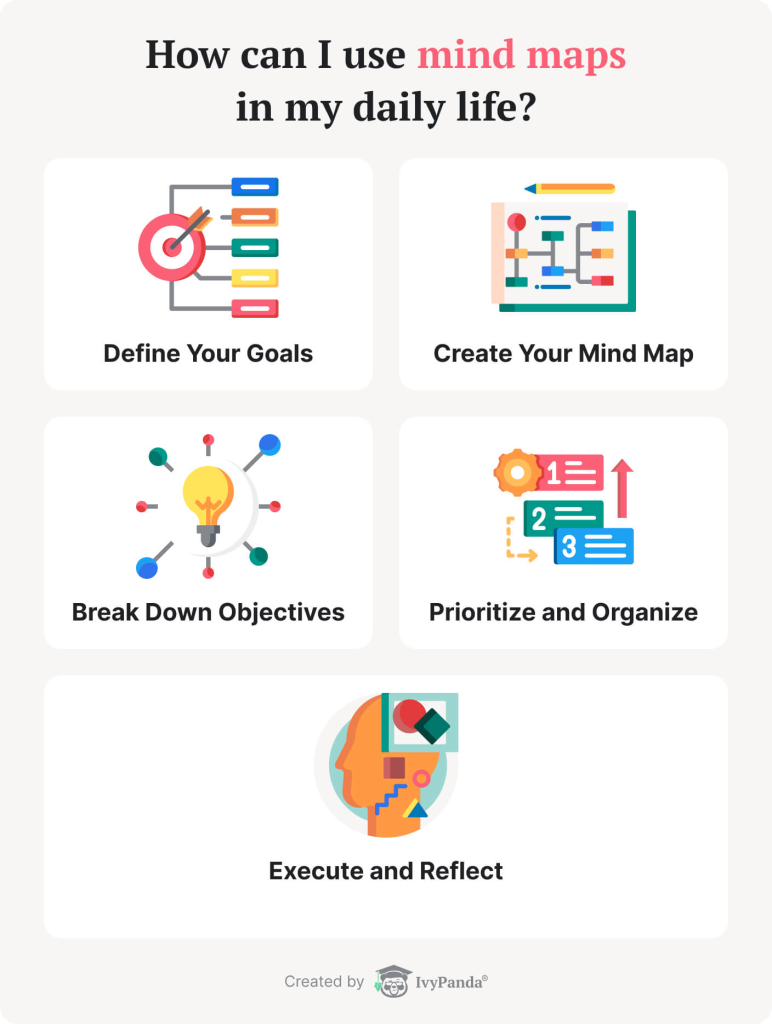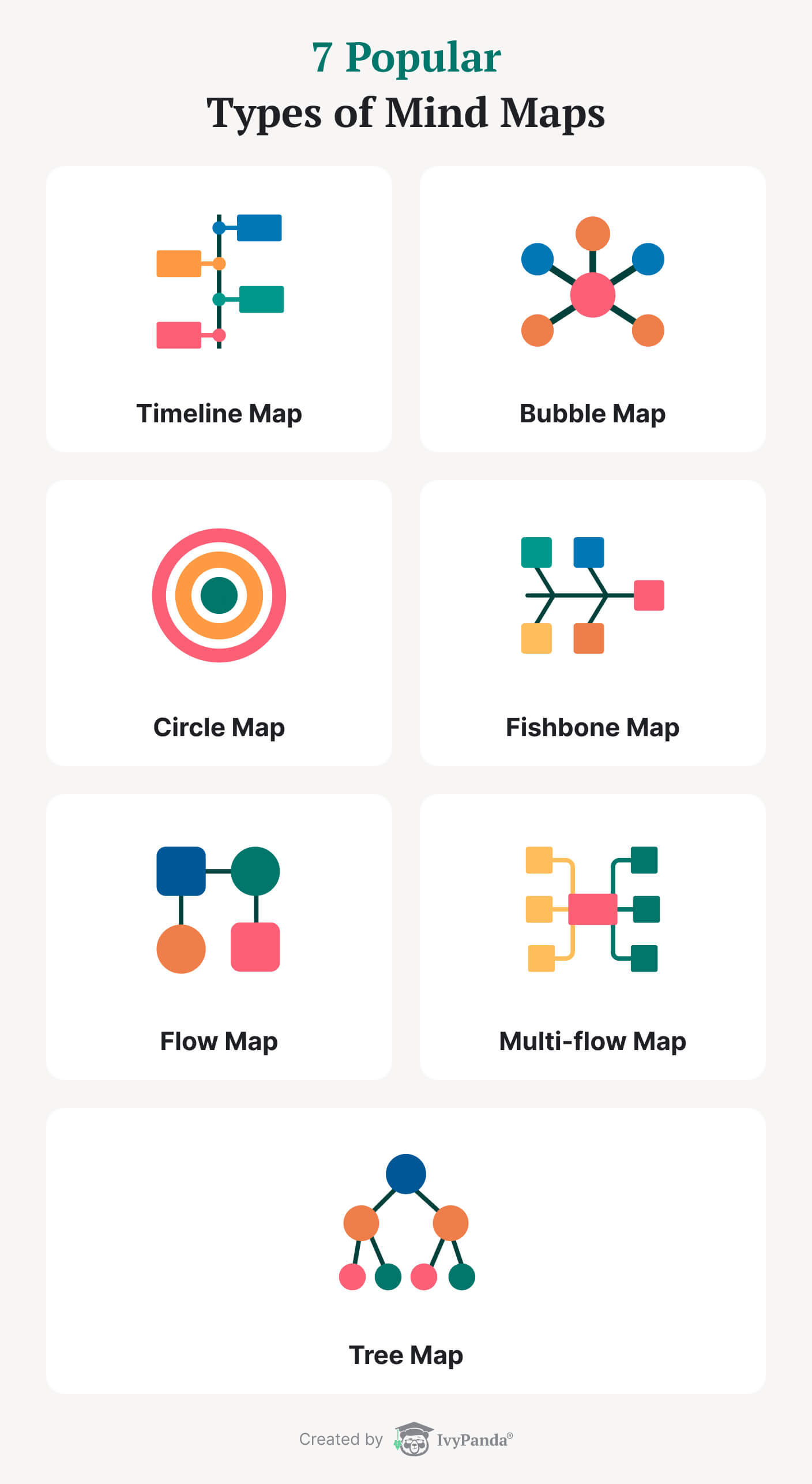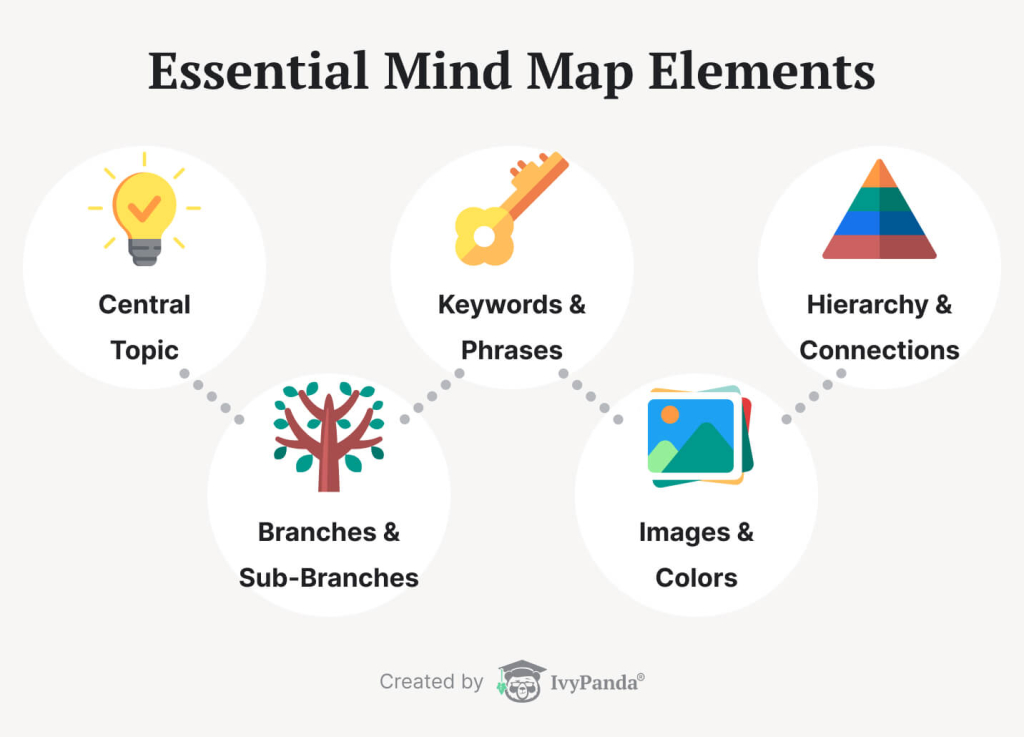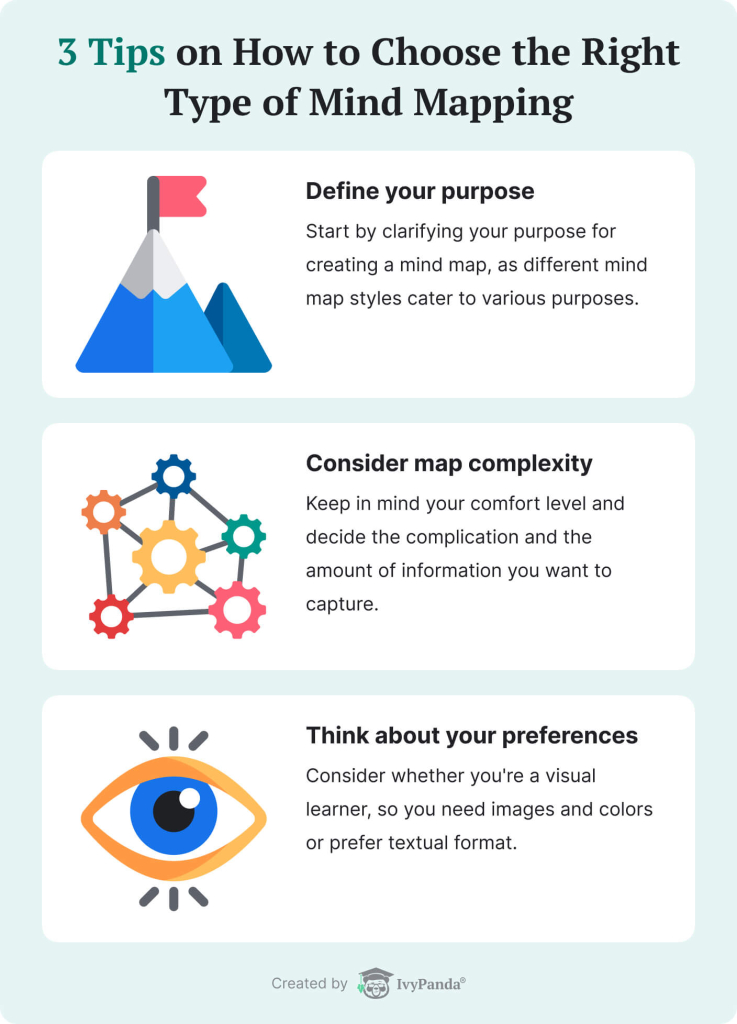Mind mapping is a powerful tool for visualizing thoughts, breaking down complex topics, and developing new ideas. Its branching structure leads you to discover an ocean of possibilities. This approach is more fun and engaging than the tedious process of taking notes, which often turns into mindless textbook rewriting. Mind maps allow people to tap into their creative side, whether working with a piece of paper or a dedicated piece of software.
Our team has prepared a guide that will uncover your mind’s potential and let it soar on the wings of creativity. Mind maps offer an incredibly flexible, accessible, and applicable way to memorize new information. You should try this effective tool for organizing ideas if improving your productivity and the quality of your academic achievements is something you’re interested in.
🧠 What Is Mind Mapping?
With the help of mind maps, it’s possible to break down subjects and show how their components relate to each other and the whole. Otherwise known as spider diagrams, they require both creativity and logic to produce. Mind maps start with a central idea and introduce related subtopics and concepts. They come in all shapes and sizes, depending on their purpose.

Each item on the diagram contains concise information about a subject’s different aspects in various colored boxes. They are connected with lines that symbolize the relationship of these components. Mind maps allow students to learn new materials faster, brainstorm ideas for writing their academic papers, and quickly revise concepts without burying themselves in learning materials.
Why Mind Mapping Is a Powerful Tool
Students should use any tool they can to master different subjects. Mind maps are one of the most powerful instruments at their disposal, with several factors that make them an irreplaceable study aid.
- They follow the pattern of your thoughts. You might not have realized this at first glance but mind maps closely resemble the neural connections in the human brain. When you think about one thing, your mind easily connects it to related ideas. A mind map works the same way.
- It diversifies your thinking. Spider diagrams require using both sides of the brain. The left hemisphere populates them with images, art, and words, while the right hemisphere makes sure they are logical and factually correct.
- The brain is drawn to color. Human brains become tired from monotonous information intake. That’s why you feel worn out after reading for a long time. Mind maps use an explosion of colors, increasing your likelihood of remembering things.
- They have endless applications. Maps make it easy to establish connections, links, and patterns in studies. With their help, memorizing, reevaluating, or revising a subject is a smoother experience.
Mind Maps vs. Text Notes
Despite the efficiency of mind maps, many still use text notes in their studies. While this tool has a lot of advantages, spider diagrams have many aces up their sleeves.
Text notes are less effective because they…
- Offer a limited view of the topic. Notes are of little help when you are trying to get a bird’s eye view of the subject. You may end up working through entire books to find specific facts.
- Take more time to complete. Writing notes is physically demanding and time-consuming. It’s a repetitive process that makes information retention less likely.
- Can be difficult to process. Students often mindlessly make notes without taking the time to process their writing. They end up wasting hours trying to understand their memos.
- Have worse navigation. Most notes are made in sentences that don’t demonstrate connections between the concepts. So, you end up with volumes of data with no good way to piece them together.
- Are disorganized. College students often leave their notes all over the place. They write them by hand or use other input types, making it challenging to have them on hand when needed.
On the other hand, mind maps are effective because they promote…
- More engaging content. Mind maps include images, colors, numbers, and words, making them memorable. They are a more efficient learning aid than plain text.
- Use of associations. This tool connects concepts through associative links. They help students develop new ideas and understand subjects more thoroughly.
- Summarization of complex subjects. With mind maps, college students can quickly examine complicated concepts and ideas. Since ideas flow from one to another in a logical manner, there is less confusion.;
- Better thought process. Mind maps use non-linear thinking, mimicking the way the human brain functions. One glance at a well-made diagram shows how everything falls into place without closely examining each component.
- Faster idea generation. Spider diagrams are a great source of inspiration and exploration of new concepts. Expand them indefinitely without losing your grasp on different aspects of the core subject.
✅ Key Reasons to Use Mind Maps to Study
Mind maps contain too many benefits for one article to cover. That’s why we’ve decided to focus on the most helpful ones for your academic progress.
- Better information retention. Mind maps ensure that people memorize facts more easily and are less likely to forget them. This is thanks to the sequential structure of these diagrams that show connections between ideas and the central concept.
- Faster learning of new concepts. Students use mind maps to learn new things during their classes and on their own. All you need is to place information on the diagram and connect the dots.
- Improving creative thinking. This process encourages creativity and freedom of thought. In turn, it makes you look at things from different angles.
- More engaging learning. Unlike other study tools, mind maps offer a more exciting study approach. It’s way more fun than listening to hours of lectures or pushing your way through endless notes.
- Breaking down complicated subjects. Mind maps make studies more approachable since dense topics are broken down into simplified parts.
- Increased productivity. Aside from being flexible and pleasing to the eye, spider diagrams are also convenient. The faster you learn something, the more quickly you find a use for it, and there’s no timelier solution than mind maps.
- High applicability. Spider diagrams’ applications are limitless. Students develop them to brainstorm ideas for all types of academic work, including essays, research papers, and scientific experiments.
- Better collaboration. The visual aspect of mind maps makes them ideal for group projects. All participants provided suggestions for the diagram, leading to a more fruitful interaction.
- Improved problem-solving skills. A sound mind map helps with your personal and academic work. For example, it can assist you in finding affordable housing that offers a fast commute to campus or tackling a complex assignment like a dissertation.
- Discover new thought patterns. Finally, this tool helps people find new associations between concepts and ideas through visual aids. It allows you to understand things you’ve never encountered before quickly and easily.
How Can I Use Mind Maps in My Daily Life?
Here, you can explore the practical integration of mind maps into everyday routines. Discover the simple way to try mind mapping and enriching your lifestyle.

Mind Mapping and Mental Health
Many believe that mind maps are for educational purposes only. You might be surprised that they can significantly improve your mental health.
- Setting goals for personal goals. Use mind mapping to break down goals that will help you grow as a person. For example, you can use it to help you overcome depression by finding and addressing its causes.
- Emotion regulation. This tool helps people who struggle to control their emotions. By creating a diagram of their feelings, they can begin to identify what triggers them. This will lead to long-lasting and practical mental health solutions.
- Dealing with habits and patterns. Use spider diagrams to find behavioral patterns and habits you want to eliminate. For example, if you wish to quit smoking, identify what keeps you from doing so and how to deal with this addiction.
⚡ 7 Popular Types of Mind Maps
Mind maps come in many shapes and colors. Students and everyone else can explore several types of these diagrams for various purposes.

- Timeline map. It is a valuable tool for students because it can visually represent chronological events and their relationships. Presenting historical or sequential information in a linear format facilitates better understanding and memorization of dates and related events. Such a map is a marvelous helper in history class.
- Bubble map. This type of map describes ideas and concepts in a condensed manner. Bubble maps use many carefully selected adjectives to describe various subjects. It’s one of the most accessible mind maps to master.
- Circle map. People use circle diagrams to show a concept in detail. Students logically format and compose brainstormed ideas with their help.
- Fishbone map. This unusual diagram shows how different processes connect to a single concept. It’s an excellent tool for making categories and revealing the origin of problems.
- Flow map. This diagram is irreplaceable for data sequences. You may structure them vertically or horizontally in an ascending or descending manner. It is mainly used for theoretical work and scientific studies.
- Multi-flow map. These maps clarify the purpose of specific topics, concepts, and ideas. Researchers and those conducting predictive studies use multi-flow diagrams in their daily work.
- Tree map. With the help of tree maps, students effectively work with large volumes of information. They allow you to break down the data and divide it into manageable categories. Editors, writers, and authors often rely on tree maps in their works.
🪄 How to Create Mind Maps: Step-by-Step Instructions
Mind maps may seem complicated if this is your first time using them. We have dedicated this guide segment to the basics of creating spider diagrams. It will serve as a template for all future mind maps you’ll develop.
- Find a central topic. Creating a mind map involves deciding on the primary subject and placing it in the center bubble. Use vivid colors and capitalized font that distinguishes it from other items on the diagram. Review the sources of information for titles, subtitles, headings, and visual cues. These will be the basis of subtopics you’ll use in a mind map.
- Introduce subtopics. During the second step, you will add branches of subtopics that stem from the center. Each represents a category of ideas related to the main topic. On average, a spider diagram will have between 4 to 7 subcategories. Make their descriptions concise to quickly understand their relation to the central theme. Using different colors also helps distinguish between ideas.
- Add information on all sub-topics. Add even smaller sections of detailed data to every map branch to further identify the depth of content. Specify starting points for each segment of relevant data. This helps avoid having too many child branches on a mind map. To keep things consistent, make them the same color as the sub-topics.
- Mix things up with images. Students learn and memorize information by adding images. Use simplistic designs to communicate ideas presented on the mind map. They sometimes explain the concept more easily than phrases and keywords. Of course, this doesn’t mean your diagram should look like a cartoon printout of The New Yorker.
- Use specialized software. You can create mind maps with a pencil and paper. This works great for a small project, like an essay. However, a more extensive task may benefit from dedicated software that lets you edit old mind maps and expand them without fearing that you’ll run out of space.
Main Rules to Keep in Mind
Making mind maps is a highly creative activity. But it’s still grounded in a set of rules you should follow.

- Use keywords or short phrases for section descriptions.
- Experiment with arrows of various sizes, styles, and colors.
- Add symbols to identify various ideas and thoughts.
- Highlight ideas with proper spacing between topics.
- Apply borders and boundaries to divide branches of the diagram.
- Use upper and lower case letters to emphasize the significance of words.
- Find an impactful central image and pictures for other diagram items.
- Experiment with shapes and how they present your ideas.
- Use different fonts and styles to break down map sections further.
- Tune branch thickness to showcase specific concepts.
- Add linear hierarchies of numbers, lists, and letters.
- Utilize imagery to improve the educational content of the diagram.
Useful Tips for Creating a Flawless Mind Map
Everybody has a specific idea about what a good mind map should look like. However, we’ve gathered several tips that everyone can benefit from. Below, you’ll find the most helpful.
💡 Mind Mapping: 11 Inspiring Ideas
Mind maps are a powerful tool for various activities. Here are some of the best applications in your daily, academic, and professional life.
- Brainstorming. Mind maps remain one of the best tools for brainstorming ideas and pushing the limits of your imagination. Using association lets you find things you’ve never considered. Find a quiet place without distractions, and let your creativity flow freely!
- Categorizing data. Everyone can use mind maps for efficient data organization. You can use it to compile code, build court cases, create a business plan, and even keep track of the various taxes you must pay.
- Creating presentations. College students use mind maps to improve the quality of their presentations and assignments and to demonstrate the significant points of work they wish to cover. Spider diagrams also help to decide the order of slides and their content.
- Dividing tasks into group projects. This method lets students or anybody involved in group projects better separate the workload between involved parties. Mind maps are also great for establishing the strengths and weaknesses of each team member. This way, you understand who should work on what part of the project.
- Essay writing. Spider diagrams allow students to come up with ideas for essay topics. Develop several and narrow them down until you pinpoint the right one. This is the perfect solution when you’re experiencing writer’s block.
- Financial planning. Students don’t always have the funds to cover all expenses. Mind maps let them manage their finances more efficiently. Use the diagram to see what you don’t need and then eliminate those expenses.
- Making notes. Instead of using data input types like words and audio, try using mind maps to take notes. Many people discover they can better comprehend and remember concepts with this method. Use them occasionally to see how old and new ideas connect.
- Organizing events. Events are notoriously time-consuming and take a lot of preparation. Mind maps let you organize various details like the list of guests, appetizers, venues, and other important parts of the event. Maps open up different options for your event.
- Learning languages. Mind maps are visual aids that are useful when mastering new languages. Use them to learn times, adjectives, nouns, sentence structure, etc. It’s a great addition to your classes or Duolingo lessons.
- Preparing for exams. Students have a hard time reviewing for upcoming exams. Mind maps help them prepare better without going through books and study guides. You’ll spend time reviewing only the areas where your preparation is lacking.
- Time management. With mind maps, students take full advantage of their daily schedule. They will have enough time for sleep, studying, self-care, and entertainment. Having discipline will ensure that they won’t falter in their academic pursuits.

🤩 5 Handy Online Tools for Mind Mapping
Drawing mind maps by hand can be a challenging and tedious process. Luckily, many free software products make it more attractive and less time-consuming. Moreover, working with mind map apps is also a more environmentally friendly choice.
- Canva
This free app has templates and tools for successful mind mapping. It’s a valuable solution for studying, making business plans, and working on projects. Finished diagrams can be imbued with reports and presentations. Add pictures, links, videos, icons, and symbols to make maps more engaging. Once you’re done, share them via email or social media accounts. - Coggle
This solution is perfect for group projects. Its interface allows people to work on plans, brainstorm ideas, and add notes. Coggle shows the history of mind maps and their versions so you can return to older editions without losing the current one. Export and share finished maps in PDF, JPEG, and Microsoft Visio format. - EdrawMind
EdrawMind’s strength is that it’s a cross-platform software. Create and edit maps during lectures on your smart device and when studying at home. Its interface lets you build topics, draw relationship lines, and add pictures, attachments, tags, links, and notes. EdrawMind comes with twelve diagram layouts and many available templates. - GitMind
With GitMind, breaking down complex concepts and creating new ideas is possible. The free tool offers many templates for your study and personal needs. Each comes with a plethora of backgrounds, branches, and colors. Students work with the layout of mind maps in such types as tree charts, fishbone, and logic charts. - Mind Manager
This free solution is a perfect tool for coming up with new ideas. MindManager creates diagrams for group and individual projects. Like other free tools, its maps help you see the relationship between concepts. Students may also create Onion and Venn diagrams with Mind Manager’s help.
Now that you know the basics of mind mapping techniques, are you ready for the changes this knowledge brings? We hope you’ll use our valuable study tips and guidelines to make your first diagram. See for yourself how it will lead you to new feats of creativity and productivity. Don’t forget to share your findings with fellow students!
📎 References
- Interactive Mind Map – Creating Bonds Among New Learners. – Dr Malgorzata Trela and Dr Sophie Rutschmann, University of Sussex
- The Mind Map as a Tool for Critical Thinking. – University of South Carolina
- 12 Mind Map Examples (with Definition, Benefits and Steps). – Indeed
- Concept Maps – Kent State University
- Mind Mapping – University of Arizona Libraries
- Concept/Mind Mapping – The University of Utah



